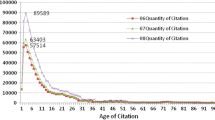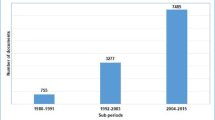Abstract







Similar content being viewed by others
Notes
This can be achieved in Network Workbench.
We can get a comparatively stable result via Fruchterman–Reingold algorithm and optimize with Kamada–Kawai, which can done with Pajek. For the detailed information about this, please refer to de Nooy et al. (2004).
The classification between the two data source is different, e.g., the articles on information economics are classified into information science in CSSCI, while they may be sorted to economics in SCI or other database. Although the classification difference may be small, we should explain the results between this study and Zhao and Strotmann’s prudently and carefully.
References
Ahlgren, P., Jarneving, B., & Rousseau, R. (2003). Requirements for a cocitation similarity measure, with special reference to pearson’s correlation coefficient. Journal of the American Society for Information Science and Technology, 54(6), 550–560.
Chen, C. (2003). Mapping scientific frontiers: The quest for knowledge visualization. London: Springer.
Chen, C. F., Wu, G., et al. (2008). The development of LIS in China since 1978. Document, Information & Knowledge, 5, 5–14.
de Nooy, W., Mrvar, A., Batagelj, V. (2004). Exploratory social network analysis with Pajek (p. 17). London: Cambridge University Press.
Hou, H. Y., Liu, Z. Y., et al. (2006). Map of science studies: the trend of research fronts. Science Research Management, 27(3), 90–96.
Leydesdorff, L., & Vaughan, L. (2006). Co-occurrence matrices and their applications in information science: Extending ACA to the web environment. Journal of the American Society for Information Science and Technology, 57(12), 1616–1628.
Liu Y., Ye J.Y., & Yuan X. L. (2009). Lack of empirical research in Chinese library science. Journal of Library science in China, 4, 14–20.
Ma, R. M. (2009). A research on scientific communication on the basis of author academic relationships. Doctoral dissertation. Wuhan: Wuhan University.
Ma, R. M., Ni, C. Q., Dai, Q. B., & Li, X. L. (2009). An author co-citation analysis of information science in China with Chinese Google scholar search engine. Scientometrics, 81(1), 33–46.
Ma, F. C., & Song, E. M. (2006). An author co-citation analysis of information science in China. Journal of the China Society for Scientific and Technical Information, 25(3), 259–268.
McCain, K. W. (1990). Mapping authors in intellectual space: A technical overview. Journal of the American Society for Information Science, 41(6), 433–443.
Qiu, J. P. (2007). Informetircs. Wuhan: Wuhan University Publishing House.
Qiu, J. P. (2011). An evaluation report on Chinese universities. Beijing: Science Press.
Qiu, J. P., & Ma, R. M. (2006). A bibliometric study of LIS based on CSSCI. Journal of Library Science in China, 1, 24–29.
Qiu, J. P., Ma, R. M., & Li, Y. J. (2008). Re-cognitions and re-thoughts on co-citation analysis. Journal of the China Society for Scientific and Technical Information, 27(1), 69–74.
Qiu, J. P., & Wen, F. F. (2011). The hot tops and research fronts of LIS in past five years. Journal of Library Science in China, 2, 51–60.
Schvaneveldt, R. W. (1989). Pathfinder associative networks: Studies in knowledge organization. New Jersey: ABLEX Publishing Corporation.
Wang, S. C., & Zhao, C. M. (2006). The survey and thought about the education of LIS. Document, Information & Knowledge, 114(6), 43–48.
White, H. D. (2003). Pathfinder networks and author cocitation analysis: A remapping of paradigmatic information scientists. Journal of the American Society for Information Science and Technology, 54(5), 423–434.
White, H. D., & Griffith, B. C. (1981). Author cocitation: A literature measure of intellectual structure. Journal of the American Society for Information Science, 32, 163–171.
White, H. D., & McCain, K. W. (1998). Visualizing a discipline: An author co-citation analysis of information science, 1972–1995. Journal of the American Society for Information Science and Technology, 49(4), 327–355.
Zhao, D. Z. (2003). A comparative citation analysis study of web-based and print journal-based scholarly communication in the XML research field. Tallahassee: The Florida State University.
Zhao, D. Z., & Strotmann, A. (2008). Comparing all-author and first-author co-citation analyses of information science. Journal of Informetrics, 2, 229–239.
Zhou, Z. Y. (2011). Strategic transformation of postgraduate education of LIS. Information Science, 29(6), 957–969.
Zhou, T., & Liu, Y. (2006). Retrospection and expectation of library and information science education in China. Library Journal of Henan Province, 26(4), 6–8.
Zhu, X. F., Zhou, W. L., & Chang, Y. L. (2008). A visualization system of ACA for Chinese author relationship. Journal of the China Society for Scientific and Technical Information, 27(4), 572–577.
Acknowledgments
The author would like to acknowledge Ning Ma, Yuan Wang, Yanhong Bi and Lifang Mu for the English revision of the manuscript.
Author information
Authors and Affiliations
Corresponding author
Rights and permissions
About this article
Cite this article
Ma, R. Discovering and analyzing the intellectual structure and its evolution of LIS in China, 1998–2007. Scientometrics 93, 645–659 (2012). https://doi.org/10.1007/s11192-012-0702-0
Received:
Published:
Issue Date:
DOI: https://doi.org/10.1007/s11192-012-0702-0
Keywords
- Author cocitation analysis
- Intellectual structure
- Library and Information Science
- Domain mapping
- Visualization
- China




